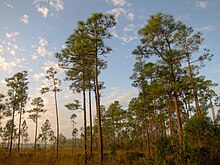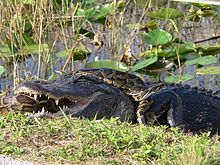Everglades National Park
The Everglades are a network of wetlands and forests fed by a river flowing 0.25 miles (0.40 km) per day out of Lake Okeechobee, southwest into Florida Bay.
As the 20th century progressed, water flow from Lake Okeechobee was increasingly controlled and diverted to enable explosive growth of the Miami metropolitan area.
Everglades National Park covers 1,508,976 acres (2,357.8 sq mi; 6,106.6 km2), throughout Dade, Monroe, and Collier counties in Florida, at the southern tip of the Atlantic coastal plain.
[11] Tiny bits of shell, sand, and bryozoans compressed over multiple layers forming structures in the limestone called ooids, which created permeable conditions that hold water.
[20] At the turn of the 20th century, common concepts of what should be protected in national parks invariably included formidable geologic features like mountains, geysers, or canyons.
They rise several inches above the grass-covered river and are dominated by diverse plant life consisting of subtropical and tropical trees, such as large southern live oaks (Quercus virginiana).
Trees often form canopies under which animals thrive amongst scrub bushes of wild coffee (Psychotria), white indigoberry (Randia aculeata), poisonwood (Metopium toxiferum) and saw palmetto (Serenoa repens).
Trees in the Everglades, including wild tamarind (Lysiloma latisiliquum) and gumbo-limbo (Bursera simaruba), rarely grow higher than 50 feet (15 m) because of wind, fire, and climate.
Mammal species living in hardwood hammocks include Florida black bears (Ursus americanus floridanus), red foxes (Vulpes vulpes), minks (Neogale vison), marsh rabbits (Sylvilagus palustris), gray foxes (Urocyon cinereoargenteus), white-tailed deer (Odocoileus virginianus), and the rare, critically endangered Florida panther (Puma concolor couguar).
Prescribed burns in these areas take place every three to seven years; without regular fires, hardwood trees begin to grow in this region, and pinelands become recategorized as mixed swamp forests.
Woodpeckers, eastern meadowlarks (Sturnella magna), loggerhead shrikes (Lanius ludovicianus), grackles, and northern mockingbirds (Mimus polyglottos) are commonly found in pinelands.
Mammals in cypress regions include white-tailed deer, squirrels, raccoons, opossums, skunks, swamp rabbits, river otters (Lontra canadensis), and bobcats, as well as small rodents.
[40] Within the Florida mangrove systems live 220 species of fish, and a variety of crabs, crayfish, shrimp, mollusks, and other invertebrates, which serve as the main source of food for many birds.
[47] The bay's many basins are broken up by sandbanks that serve as plentiful recreational fishing grounds for snook (Centropomus undecimalis), redfish (Sciaenops ocellatus), spotted seatrout (Cynoscion nebulosus), tarpon (Megaflops atlanticus), bonefish (Albula vulpes), and permit (Trichinous falcatus),[48] as well as snapper (Lutjanus campechanus), bluegill (Lepomis macrochirus), and bass.
[49] Wading birds such as roseate spoonbills (Platalea ajaja), reddish egrets (Egretta rufescens), and great white herons (Ardea herodias occidentalis) have unique subpopulations that are largely restricted to Florida Bay.
[54] Shell mounds still exist today within the park, giving archaeologists and anthropologists evidence of the raw materials available to the indigenous people for tool construction.
Following the end of the Seminole Wars, Americans began settling at isolated points along the coast in what is now the park, from the Ten Thousand Islands to Cape Sable.
Communities developed on the two largest pieces of dry ground in the area, on Chokoloskee Island and at Flamingo on Cape Sable, both of which established post offices in the early 1890s.
The settlements in Chokoloskee and Flamingo served as trading centers for small populations of farmers, fishermen, and charcoal burners settled in the Ten Thousand Islands.
Miami Herald editor John Pennekamp was instrumental in pushing the Florida Legislature to raise $2 million to purchase the private land inside the park boundaries.
[85] The same year, several tropical storms struck South Florida, prompting the construction of 1,400 miles (2,300 km) of canals, sending water unwanted by farmers and residents to the ocean.
The airport proposal was eventually abandoned, and in 1972 a bill was introduced to curb development in South Florida and ensure the national park would receive the amount of water it needed.
It was a controversial plan; detractors worried that it "relies on uncertain technologies, overlooks water quality, subsidizes damaging growth and delays its environmental benefits".
[93] Supporters of the plan included the National Audubon Society, who were accused by Friends of the Everglades and the Biodiversity Legal Foundation of prioritizing agricultural and business interests.
Such storms are a natural part of the park's ecosystem; 1960's Hurricane Donna left nothing in the mangroves but "standing dead snags" several miles wide, but 30 years later the area had completely recovered.
Several walking trails in the park vary in hiking difficulty on Pine Island, where visitors can cross hardwood hammocks, pinelands, and freshwater sloughs.
It loops through a canopy of hardwood hammocks that include gumbo limbo (Bursera simaruba), royal palms (Roystonea), strangler figs (Ficus aurea), and a variety of epiphytes.
[111] Low-powered motorboats are allowed in the park; the majority of salt water areas are no-wake zones to protect manatees and other marine animals from harm.
The experts who compiled the results justified the score by stating: "Encroachment by housing and retail development has thrown the precious ecosystem into a tailspin, and if humankind doesn't back off, there will be nothing left of one of this country's most amazing treasures".
[127] The biggest threats to the panther include habitat destruction from human development, vehicle collisions, inbreeding due to their limited gene pool, parasites, diseases, and mercury poisoning.



















